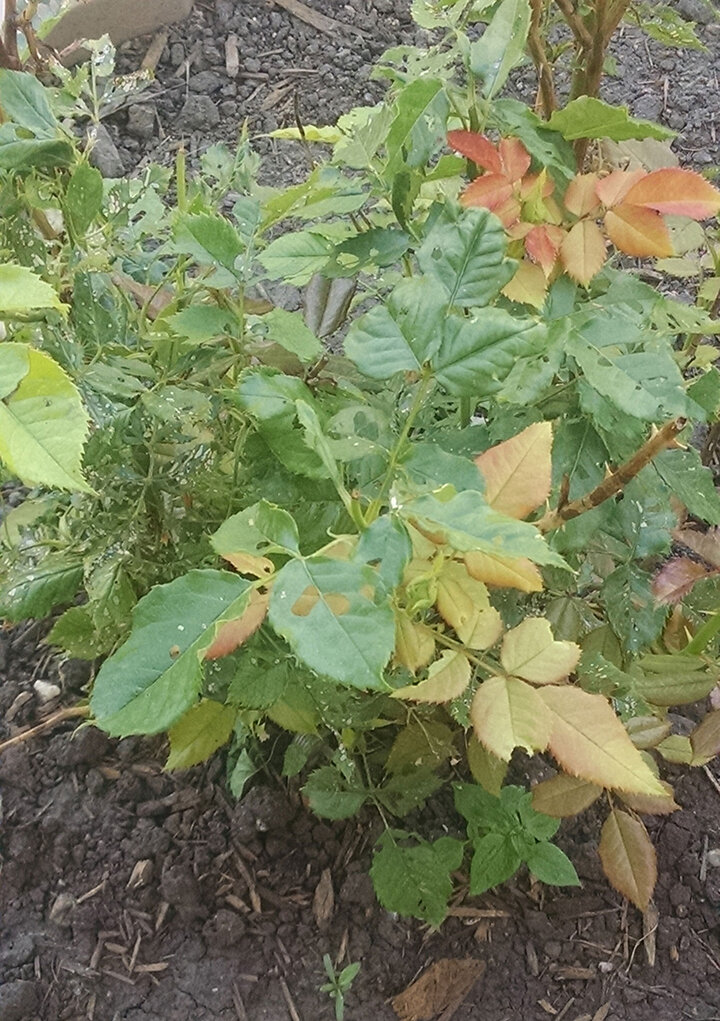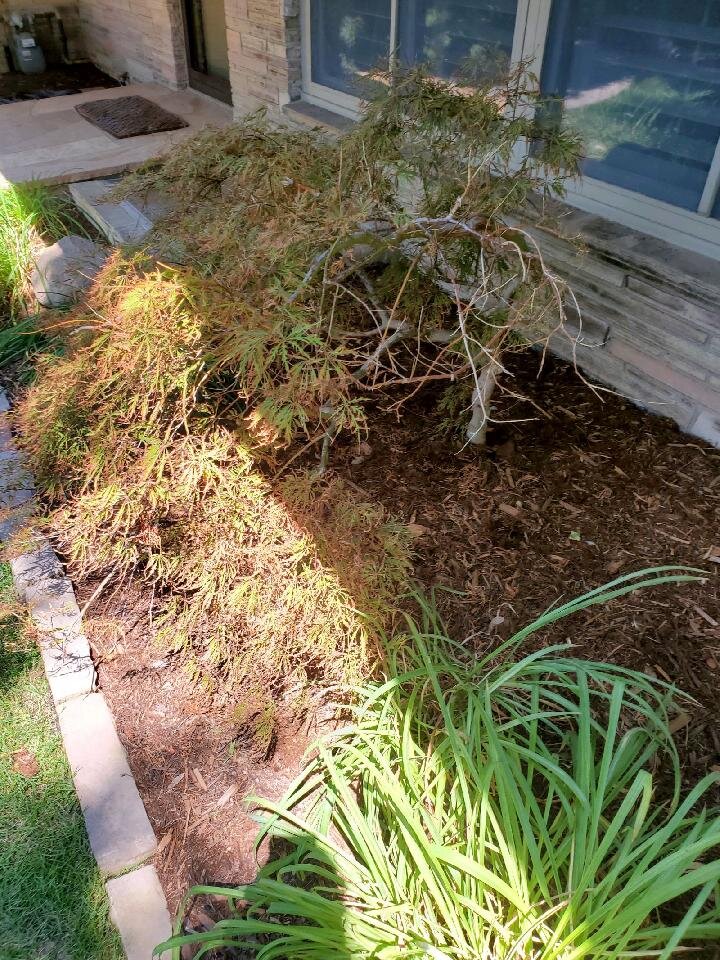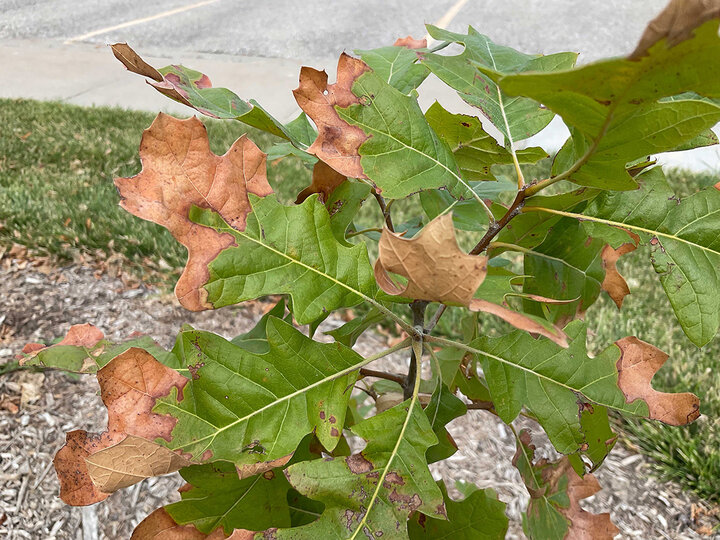Sarah Browning, Nebraska Extension Educator

Nutrient deficiency symptoms in spruce. Image by Sarah Browning, Nebraska Extension
During landscape clean up at season’s end, it’s a good time to assess your plantings’ performance and make plans for next season. If problems occurred, how did they present? Were scattered, unrelated plants affected? Or were all plants in one section of the landscape showing symptoms? How problems present can give a clue as to the potential problems and help you develop a plan to improve next year.

Pest Problem or Environment?
If only one specific kind of plant - for example roses or cucurbits - had a problem this season, it could be a disease or insect problem. Most plant-damaging insects and diseases are very host specific, in that they attack only plants within a species or within closely related species, rather than a number of different species. If it appears an insect or disease was the culprit, then next year when the problem first appears send pictures or bring samples to your local Nebraska Extension office. We can help you diagnose the problem and develop a good plan for control.

Wrong Plant, Wrong Place?
But it could also be the problem plant didn't have the right growing conditions or just is not adapted to our climate. For example, a rose growing in too much shade is very prone to infection by powdery mildew. A Japanese maple planted in full sun, on a hot dry windy site really doesn’t have much chance at survival in Nebraska.
But, that same rose in full sun will have no disease. And the Japanese maple given some afternoon shade in a sheltered location away from wind, correctly watered, at least has a chance. In this case, the best solution to the problem is moving the plant to a location better matching its growing needs.
Matching plants to site conditions available in your garden or landscape is critical to their success, along with choosing well-adapted plants. For example, Japanese maples often struggle in Nebraska even on a good site. So swapping it out for a serviceberry, Corneliancherry dogwood or an attractive shrub is an even better idea. Take time this winter to research plant needs before deciding to plant them and consider replacing existing plants with chronic problems due to a site or climate mismatch.
Problems affecting most or all yard and garden plantings - such as the entire vegetable garden or flower bed - are more likely caused by the general environment or growing conditions in your landscape. Common causes include too much or not enough water and soil issues, although too much or too little light, herbicide drift, high winds, hail and other environmental issues can cause problems, too.

Water Problems
What are the soil moisture levels in your problem area? Are plants getting too dry and developing leaf scorch by late summer? If so, relocating problem plants to a moister area of the landscape is one option. Or develop an irrigation plan to ensure drought affected plants get the water they need to grow well.
Another option is to remove the problem plants, replacing them with something more drought tolerant. Check out the publication below for good suggestions on drought tolerant perennials
Perennials in Water-Wise Landscapes, Nebraska Extension.
Soil Compaction
Soils are a critical part of the success or failure of individual plants or an entire garden. Common problems related to soil include compaction, drainage and soil pH. Compaction and drainage problems often occur together since compacted soils also have poor drainage.
Newly constructed homes - those built within about the last 20 years - often have compacted soil issues. Compaction reduces plant growth and vigor by decreasing the amount of oxygen penetrating into the soil and decreasing plant root growth. Poor water infiltration is another problem with compacted soil and also has an impact on plant root growth. Ideally compaction is addressed before a new planting bed is created, by physically loosening the soil through tillage or spading and adding organic matter.
But it can also be done when replacing a plant that has died. Make sure to dig a wide hole for the new plant, loosening the soil around the plant so new roots have an easier time growing and expanding. However, we no longer recommend adding organic matter into the planting hole. The plant is better off growing directly into unamended native soil, unless the entire area where the plant’s root system will be growing can be amended – which usually is either not possible or an undertaking gardeners are not willing to do.
Soil pH
Eastern Nebraska tends to have alkaline soil or high soil pH, which can cause problems for some plants, like river birch, big-leaf hydrangeas and blueberries to name a few. Alkaline soil changes the availability of certain plant nutrients, often making them less available. Iron chlorosis, characterized by light green or yellow leaves with darker green veins, is one of the most common soil pH-induced nutritional deficiencies and is also common in the plants mentioned above.
However, changing soil pH is difficult, if not impossible. Many horticulture researchers now agree that rather than trying to amend soil pH, the better option is choosing plants adapted to alkaline soil.
Not sure if your plant problems are soil pH related? Do some research to determine the preferred soil pH for the plants you’re growing. Missouri Botanical Garden Plant Finder.
Look up, view a photo and read about the over 7,500 plants which are growing or have been grown in the Kemper Center display gardens (plus selected additions) by scientific name, common name and/or selected plant characteristics.
is a great tool for finding in-depth plant information. Or take samples of your plant to your local Nebraska Extension office for diagnosis. If you’re trying to grow plants that prefer acidic soil, that might be the problem.
Next, have a soil test done through your local soil testing lab to determine your soil pH. If alkaline soil is the problem, then avoid plants prone to iron chlorosis or sensitive to alkaline soil.
Keep all these factors in mind as you review this growing season and you may be able to eliminate some of your “problem plants” next year.
Images
- Determining the cause of problem symptoms, as with this rose, is key to develop a successful management strategy. Sarah Browning, Nebraska Extension
- Start off on the best foot, by choosing well-adapted plants. Marginally adapted plants, like this Japanese maple, will often struggle and be easily stressed by less than ideal site and weather conditions. Client picture used with permission.
- Are the dead lesions on this black oak's leaves an environmental (watering) problem or a disease? Sarah Browning, Nebraska Extension.
Search Our Archive
Associated Video
Spruce Diseases
UNL Extension Assistant Plant Pathologist Kevin Korus shows us three different spruce diseases and talks about how to avoid them